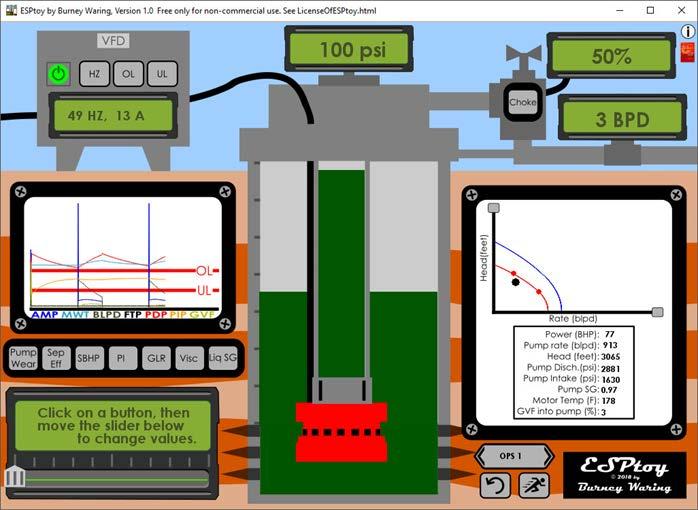
3 minute read
Innovation
ESPtoy: Educational Simulation Software about Oilfield ESPs
Burney Waring Former Principal Technical Expert at Shell and Director of Retirement Testing at Waring Retirement Laboratory
Advertisement
ESPtoy is an instructional simulator that I built to help teach Engineers and Operators about the dynamic performance of Electric Submersible Pump (ESP) systems. It’s free for non-commercial use. I was lucky to have 50+ LinkedIn friends help me test ESPtoy, catching many bugs, problems and providing so many great ideas. I made a work-toy! Ihope you have fun with it.
Instructional Simulations Decades of teaching Engineers and Operators inside oil and gas companies around the world have required me to learn various instructional techniques. I struggled with teaching certain topics where dynamic behaviors were involved and where there were multiple interacting variables so I started using simulations. Simulations have definitely helped my students to learn difficult topics.
Gamification The gamification of learning is a huge area of R&D and practice. My own most ‘pure’ form of gamification: I ran an exercise for experienced engineers called “Production Technology Quiz Bowl”. Back to ESPtoy, it is very easy to create ‘games’ for the learner around simulations. ESPtoy can be used in multiple game-like ways, including: The Base Case, which is the default mode, provides the user with a wide-variety of changes that they can make. In this mode, the user changes to pre-defined scenarios to see some typical things that can go wrong with ESPs, and then must come up with ways to mitigate these problems. In this mode, the user changes to pre-defined scenarios with a short backstory and must try to find the best solution. Although ESPtoy comes with 15 cases built-in, it doesn’t preclude anyone from inventing additional cases with their own descriptions and settings. Note to Instructors: If you teach any sort of software, consider adding game elements to your exercises.
2 6 Realism vs. Veracity It isn’t necessary to create a highly-rigorous simulation. For teaching purposes, the results only need to reflect a realistic behavior to give a student an intuitive sense for how a dynamic system behaves, how multiple changes interact. So, ESPtoy has the right equations and the right behaviors for increasing viscosity, specific gravity, and pump wear, but doesn’t have rigorous multiphase flow, PVT, enthalpy balance, pump catalog, hundreds of inputs, etc. that are needed in a rigorous design and analysis software.
Building ESPtoy I’ve been programming on and off for 42 years on various systems and in various languages. I chose Python for this project. Python is amazing for many reasons, but I will pick two of them: • There are multiple ways to write software, and Python can handle any of them. • I knew I wanted to build a very visual simulation and did not want to be restricted to standard Windows motif. I wanted to make what is basically a game. The Python community has a library called Pygame. If you are going to use Python, you might have a look at Anaconda to help get everything in place.
Why is ESPtoy Free? After a long debate, I decided that my primary happiness in projects like this comes from the joy of creating new things and from the feedback I get when I help people. So, to optimize my own happiness generation, I decided ESPtoy should be in the maximum number of hands possible. I’m retaining the right to negotiate the commercial uses of ESPtoy.
What’s next? Gas Lift was my second completed work toy. Working on other toys on other topics? Almost certainly, yes. For example, topics related to Production System Optimization, one of my other favorite areas of study. More information about ESPtoy: www.waringworld.com/esptoy/README. html
ESPtoy by Burney Waring, Version 1.0









